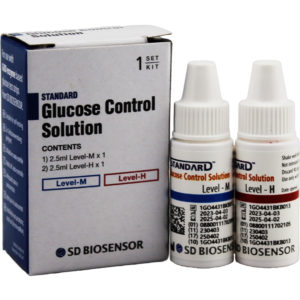Original price was: £17.99.£7.99Current price is: £7.99.
Only 4 left in stock
Introducing the SD Codefree Blood Glucose Meter, your convenient solution for monitoring blood glucose levels accurately and efficiently. This compact, handheld device offers a hassle-free way to track your glucose levels with ease. Simply use the included lancing device to obtain a small blood droplet, add it to the test strip, and let the SD CodeFree meter automatically provide you with a result. With a memory capacity of up to 500 test results, this meter ensures you have a comprehensive record of your glucose levels over time.
Key Features:
As of July the 1st 2021 the rules on VAT for EU sales will be changing. For orders less than £135 (€150) we will display the total price inclusive of the VAT rate. For orders above this amount, you will not be charged VAT and you will be required to pay this when your goods arrive in your country. Read more on the new rules here.
***SPECIAL OFFER*** for diabetics ONLY. Buy all 3 items and save £3!
The SD CodeFree Blood Glucose Monitoring Kit is an essential tool for managing diabetes at home, offering accurate and convenient blood glucose level monitoring. By pricking your finger and applying a drop of blood to the testing strip, the SD CodeFree Meter provides instant readings, allowing you to track your glucose levels effectively. With the included Self-Test diary, you can record your results to collaborate with your healthcare team for tailored treatment adjustments.
The SD CodeFree Blood Glucose Meter utilises a simple testing process, requiring only a small blood sample to be applied to the testing strip. Within 5 seconds, the meter provides accurate glucose level readings, eliminating the need for manual code entry. With its compact design and free carry case, the meter offers portability and convenience, enabling you to monitor your glucose levels anytime, anywhere.
Individuals managing diabetes who require frequent blood glucose monitoring will benefit from the SD CodeFree Blood Glucose Monitoring Kit. Whether you’re new to self-monitoring or seeking a reliable and cost-effective solution, this kit offers essential features such as large memory storage, compatibility with alternate site testing, and low-priced replacement strips. Trust the SD CodeFree Meter to simplify your diabetes management journey while ensuring accurate and timely glucose level monitoring.
Testing for diabetes at home involves using a blood glucose monitor to measure your blood sugar levels. First, wash your hands with soap and water. Next, insert a test strip into the meter and prick your finger with a lancet to obtain a small blood sample. Apply the blood sample to the test strip and wait for the meter to display your glucose level. Follow the instructions provided with your specific blood glucose monitor for accurate testing.
A healthy glucose reading typically falls within the range of 70 to 130 milligrams per deciliter (mg/dL) before meals and below 180 mg/dL two hours after meals. However, ideal glucose levels may vary depending on individual factors such as age, health condition, and whether the person has diabetes or not. It’s essential to consult with a healthcare professional to determine your target glucose range based on your specific circumstances.
Ideal blood sugar levels vary depending on various factors, including individual health status, age, and whether the person has diabetes. For individuals without diabetes, ideal fasting blood sugar levels typically range between 70 to 100 mg/dL. Postprandial (after-meal) blood sugar levels should generally remain below 140 mg/dL. However, it’s crucial to consult with a healthcare provider to establish personalised blood sugar targets based on individual health goals and medical history.
Please watch the video produced by Diabetest.co.uk about our NEW SD CodeFree Blood Glucose Meter.
For more detailed instructions, follow the detailed information guide provided with each pack.
For detailed instructions in more languages, find a range of options below;
Diabetes daily care Whichever type of diabetes you have, it’s important you come to terms with it. Living with diabetes means you will need to take responsibility for your every day care. The more you understand your condition and how it affects you, the better you will be able to control it. To help, here […]
Type 2 diabetes, also known as non insulin dependent diabetes, is the most common type of diabetes. Type 2 usually appears in older people (over the age of 40) however, as levels of obesity in the UK are rising, more and more younger people are being diagnosed. Type 2 happens either when […]
Gestational diabetes and diabetes in pregnancy Gestational diabetes is a form of diabetes that develops or is discovered during pregnancy. It typically occurs between 24 and 28 weeks of pregnancy (but can develop anytime) after the baby’s body has been formed, but while the baby is growing. It usually disappears when the pregnancy is over. What causes […]
Treatment for Type 1 Diabetes There isn’t a cure for Type 1 diabetes yet so the primary aim of treatment is to keep blood glucose levels as near to normal as possible. The quicker levels are brought under control the better the long-term health prospects. If you have been diagnosed with Type 1 diabetes, you will be […]
What complications can develop from diabetes? Health complications can occur when diabetes is not kept under control. These can range from mild to very serious so it’s very important to routinely test glucose levels and attend regular check ups. Please use the list below to familiarise yourself with common complications, symptoms and ways to prevent […]
What is Type 1 Diabetes? Diabetes (or diabetes mellitus) has two main types: Type 1 and Type 2. In this section we will be talking about Type 1. For more information on Type 2 diabetes, please click here. Type 1 diabetes, also known as insulin dependent diabetes, develops when the insulin producing cells in the pancreas have been destroyed and the body stops producing […]
The National Institute for Health and Care Excellence (NICE) have published an update to the Public Health Guideline on type 2 diabetes. In the UK, there are 3.8 million people living with diabetes, the majority of these have type 2 diabetes. If you have type 2 diabetes you are more at risk of cardiovascular disease […]
Insomnia can disrupt hormones, and may play a role in developing the blood sugar condition, expert says Women who have chronic sleep problems may have an increased risk of developing type 2 diabetes, Harvard researchers report. Problems such as trouble falling or staying asleep, getting less than six hours of sleep, frequent snoring, sleep apnea […]
There are two main types of diabetes: Type 1 and Type 2. Type 1 Diabetes Type 1 Diabetes, also known as ‘insulin dependent diabetes’, develops when the insulin-producing cells in the pancreas have been destroyed and the body stops producing its own insulin. This may be due to a combination of hereditary and environmental factors, […]
You must be logged in to post a review.




Reviews
There are no reviews yet.